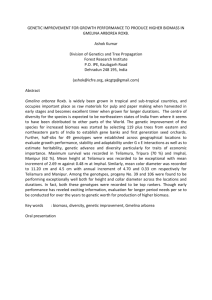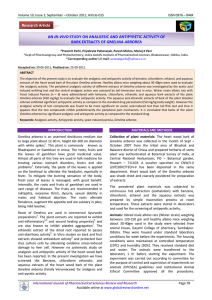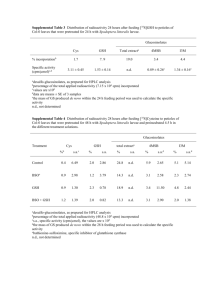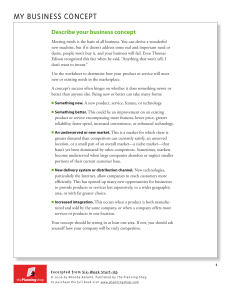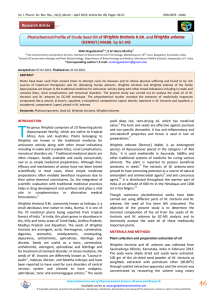Document 13308571
advertisement
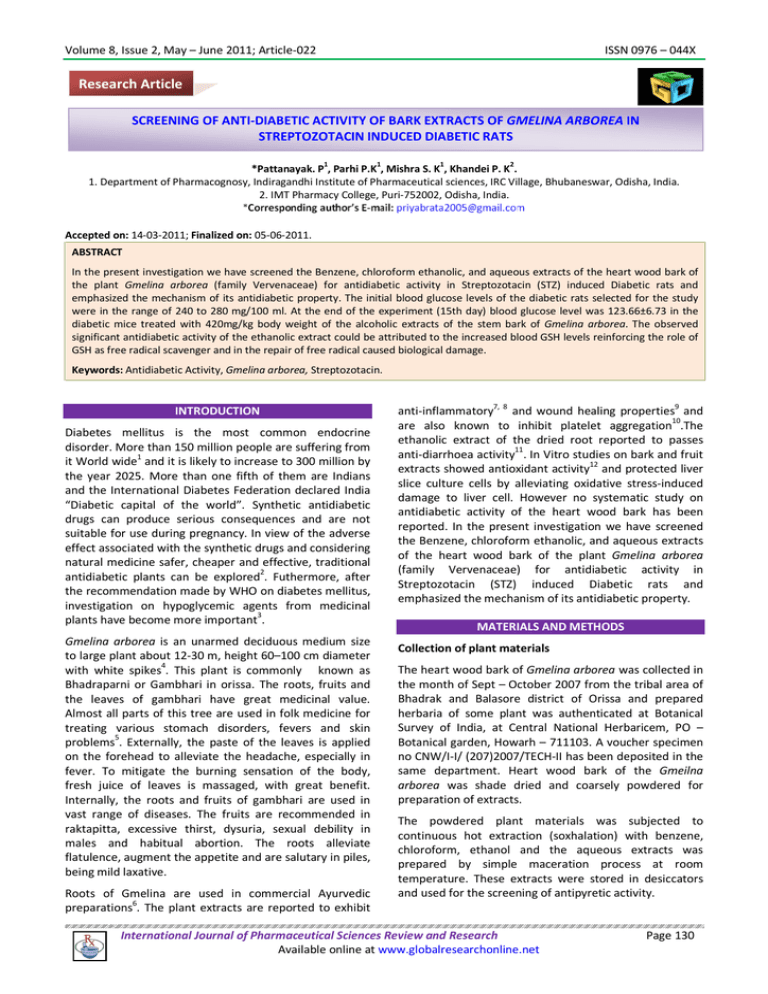
Volume 8, Issue 2, May – June 2011; Article-022 ISSN 0976 – 044X Research Article SCREENING OF ANTI-DIABETIC ACTIVITY OF BARK EXTRACTS OF GMELINA ARBOREA IN STREPTOZOTACIN INDUCED DIABETIC RATS 1 1 1 2 *Pattanayak. P , Parhi P.K , Mishra S. K , Khandei P. K . 1. Department of Pharmacognosy, Indiragandhi Institute of Pharmaceutical sciences, IRC Village, Bhubaneswar, Odisha, India. 2. IMT Pharmacy College, Puri-752002, Odisha, India. Accepted on: 14-03-2011; Finalized on: 05-06-2011. ABSTRACT In the present investigation we have screened the Benzene, chloroform ethanolic, and aqueous extracts of the heart wood bark of the plant Gmelina arborea (family Vervenaceae) for antidiabetic activity in Streptozotacin (STZ) induced Diabetic rats and emphasized the mechanism of its antidiabetic property. The initial blood glucose levels of the diabetic rats selected for the study were in the range of 240 to 280 mg/100 ml. At the end of the experiment (15th day) blood glucose level was 123.66±6.73 in the diabetic mice treated with 420mg/kg body weight of the alcoholic extracts of the stem bark of Gmelina arborea. The observed significant antidiabetic activity of the ethanolic extract could be attributed to the increased blood GSH levels reinforcing the role of GSH as free radical scavenger and in the repair of free radical caused biological damage. Keywords: Antidiabetic Activity, Gmelina arborea, Streptozotacin. INTRODUCTION Diabetes mellitus is the most common endocrine disorder. More than 150 million people are suffering from it World wide1 and it is likely to increase to 300 million by the year 2025. More than one fifth of them are Indians and the International Diabetes Federation declared India “Diabetic capital of the world”. Synthetic antidiabetic drugs can produce serious consequences and are not suitable for use during pregnancy. In view of the adverse effect associated with the synthetic drugs and considering natural medicine safer, cheaper and effective, traditional antidiabetic plants can be explored2. Futhermore, after the recommendation made by WHO on diabetes mellitus, investigation on hypoglycemic agents from medicinal plants have become more important3. Gmelina arborea is an unarmed deciduous medium size to large plant about 12-30 m, height 60–100 cm diameter with white spikes4. This plant is commonly known as Bhadraparni or Gambhari in orissa. The roots, fruits and the leaves of gambhari have great medicinal value. Almost all parts of this tree are used in folk medicine for treating various stomach disorders, fevers and skin problems5. Externally, the paste of the leaves is applied on the forehead to alleviate the headache, especially in fever. To mitigate the burning sensation of the body, fresh juice of leaves is massaged, with great benefit. Internally, the roots and fruits of gambhari are used in vast range of diseases. The fruits are recommended in raktapitta, excessive thirst, dysuria, sexual debility in males and habitual abortion. The roots alleviate flatulence, augment the appetite and are salutary in piles, being mild laxative. Roots of Gmelina are used in commercial Ayurvedic preparations6. The plant extracts are reported to exhibit anti-inflammatory7, 8 and wound healing properties9 and are also known to inhibit platelet aggregation10.The ethanolic extract of the dried root reported to passes anti-diarrhoea activity11. In Vitro studies on bark and fruit extracts showed antioxidant activity12 and protected liver slice culture cells by alleviating oxidative stress-induced damage to liver cell. However no systematic study on antidiabetic activity of the heart wood bark has been reported. In the present investigation we have screened the Benzene, chloroform ethanolic, and aqueous extracts of the heart wood bark of the plant Gmelina arborea (family Vervenaceae) for antidiabetic activity in Streptozotacin (STZ) induced Diabetic rats and emphasized the mechanism of its antidiabetic property. MATERIALS AND METHODS Collection of plant materials The heart wood bark of Gmelina arborea was collected in the month of Sept – October 2007 from the tribal area of Bhadrak and Balasore district of Orissa and prepared herbaria of some plant was authenticated at Botanical Survey of India, at Central National Herbaricem, PO – Botanical garden, Howarh – 711103. A voucher specimen no CNW/I-I/ (207)2007/TECH-II has been deposited in the same department. Heart wood bark of the Gmeilna arborea was shade dried and coarsely powdered for preparation of extracts. The powdered plant materials was subjected to continuous hot extraction (soxhalation) with benzene, chloroform, ethanol and the aqueous extracts was prepared by simple maceration process at room temperature. These extracts were stored in desiccators and used for the screening of antipyretic activity. International Journal of Pharmaceutical Sciences Review and Research Available online at www.globalresearchonline.net Page 130 Volume 8, Issue 2, May – June 2011; Article-022 ISSN 0976 – 044X Animals served as control. Group II to V received 420 mg/kg body weight of Benzene, Chloroform, Ethanol and Aqueous extracts of the barks of Gmelina arborea respectively once a day orally for 15 days using an intragastric tube. The animals marked groupVI received orally 200 mg/kg body weight of Chlorpropamide in 1 % w/v aqueous acacia solution once a day orally for 15 days and served as standard. Blood samples were collected at 5 days intervals i.e. on 1, 5, 10 and 15th day after oral administration till the end of the study. The fasting blood sugar (FBS) levels13 were measured using blood glucose test strips with elegance glucometer (Frankenburg, Germany). Blood glutathione (GSH) was estimated by the method of Beutler et.al14. Inbred male albino rats (Swiss strain) weighing between 120-150 gm were used in the study were selected from animal house, Gayatri college of pharmacy, Sambalpur. Odisha. They were housed under standard laboratory conditions for week before the experiments. The housing conditions were maintained at controlled temperature (23ºC) and humidity (50%). Prior to experiment the animals were fasted overnight but were allowed to free access to water. The animals were transferred to the laboratory 1 hr before starting the experiment. The experiment was carried out according to committee for the purpose of control and supervision of experiments on animals (CPCSEA) guidelines and Institutional Animal Ethical Committee approved all the procedures. Experiments were conducted between 9:00 to 14 hr. Each rat was used only once. Statistical Analysis The results of the biochemical estimations were reported as Mean ± SEM. The total variation present in a data was analyzed by one-way analysis of variance (ANOVA). Differences among the means were analyzed by Scheffe’s test. For this an MS-Windows based SPSS computer package was used. Determination of LD 50 LD50 was found from previously published report8. Induction of Experimental Diabetes STZ solution of 10 mg/ ml was prepared in ice-cold citrate buffer 0.1 M, pH 4.5 kept in ice and was administered within 5 minutes at a dose of 50-mg/kg-body weight intraperitoneally. After 48 hours of STZ administration, rats with moderate diabetes having glycosuria and hyperglycaemia (i.e., with a blood glucose of 200-300 mg/dl) were separated and taken for the experiment. RESULTS AND DISCUSSION The FBS levels in STZ treated rats were significantly high (p < 0.05) when compared to the normal after 5th day of diabetic induction (1st day of dug administration). The FBS values on the 1st day were 66.18±5.80 mg/dl for Group I (Control), 240 ± 15.34 mg/dl for Group II (Benzene extract), 250.33 ± 14.4 mg/dl for group III (Chloroform extract), 263 ± 20.99 mg/dl for group IV (Ethanolic extract), 281±15.62 mg/dl for group V (Aqueous extract) and 271.25 ± 19.9 for Group VI (Chlorpropamide) (Table 1). Experimental Design Five days after the induction of diabetes animals wee fasted overnight and divided into six groups of six each. The animals marked group I received orally 1ml/100gm of body weight of 1 % w/v aqueous acacia solution and Table 1: Effect of Gmelina arborea on FBS (mg/dl) and GSH (mg/dl) (Mean ± SEM). Post-Induction days Groups Control 1 5 10 15 FBS GSH FBS GSH FBS GSH FBS GSH 66.18±5.80 13.63.18±1.8 329±15.275 13.11±0.62 326±6.557 13.78±1.11 328±7.37 13.36±0.94 16.48±1.24 Benzene extract 240±15.34 16.13±0.76 312±20.984 15.57±0.59 337±13.856 15.43±1.2 296.33±24 Chloroform extract 250.33±14.4 14.63±1.14 297.66±2.603 15.2±1.27 283.33±12.6 15.23±0.86 282±20.35 16±1.54 Ethanol extract 281±15.62 13.2±0.63 260.33±6.489 14.73±0.83 198.66±10.47 21.69±1.32 123.66±6.73 24.9±1.2 Aqueous extract 263±20.99 15.71±1.0 271.33±13.73 16.2±0.44 267.66±15.37 17.45±1.02 208.33±8.51 16.37±1.2 Chlorpropamide 271.25±19.09 14.26±0.26 240.66±15.05 16.1±0.76 178.66±17.37 22.2±1.5 118±4 27.68±0.66 The GSH levels in normal rats (non diabetic rats) were 27.18±1.8 mg/dl. In STZ treated diabetic rats (Group II-IV) the GSH levels decreased significantly (p < 0.05) and increases on post treatments. Ethanol extract and Chlorpropamide treated rats (Group IV and VI) showed a significant increase (p < 0.05) in the GSH levels on both 10th and 15th post treatment days. In diabetes, oxidative stress is due to both an increased production of plasma free radical concentration and a sharp reduction of antioxidant defenses. GSH, being the most important biomolecule against chemically induced toxicity can participate in the elimination of reactive intermediates by reduction of hydro peroxides in the presence of Glutathione peroxidase. GSH also functions as free radical scavenger and in the repair of free radical 15 caused biological damage . The important mechanism implicated in the diabetogenic action of STZ is by increased generation of oxygen free radicals, which causes a decrease in plasma GSH concentration. Hence, drugs that could prevent the generation of these oxygen International Journal of Pharmaceutical Sciences Review and Research Available online at www.globalresearchonline.net Page 131 Volume 8, Issue 2, May – June 2011; Article-022 ISSN 0976 – 044X for Research in Ayurveda and Siddha, Department of ISM and H Ministry of health and Family Welfare Government of India, 2001, 217–228. free radicals or increase the free radical scavenging enzymes may be effective in STZ induced diabetes. The effect of the treatment with all extracts and Chlorpropamide on serum glucose levels and blood glutathione level in streptozotocin induced diabetic rats and in normal fasted rats are shown in Table-1. The initial blood glucose levels of the diabetic rats selected for the study were in the range of 240 to 280 mg/100 ml. At the end of the experiment (15th day) blood glucose level was 123.66±6.73 in the diabetic mice treated with 420mg/kg body weight of the alcoholic extracts of the stem bark of Gmelina arborea. Effect seems to reach maximum after 15 days of treatment and remains constant in thereafter. Whereas all other extracts at same dose doesn’t produced any significant reduction in blood glucose level. However this reduction was not as much as that seen with standard drug Chlorpropamide. Thus the alcoholic extracts of the stem bark of Gmelina arborea restored the serum glucose levels almost nearer to normal values. CONCLUSION In the present study the observed significant antidiabetic activity of the ethanolic extract could be attributed to the increased blood GSH levels reinforcing the role of GSH as free radical scavenger and in the repair of free radical caused biological damage. REFERENCES 1. 6. Tewari, D.N. A Monograph on Gamari (Gmelina arborea Roxb.), International Book distributor, Deheradun, India, 1995, pp. 1–84. 7. Agrawal VK, Gambhir SS, Wahi AK, A preliminary study on anti-inflammatory activity of some medicinal plants, Ind J Nat Prod, 10(1), 1994, 14-15. 8. Barik BR. et al. Premnazole, an isoxazole alkaloid of Premna integrifolia L. and Gmelina arborea L. with antiinflammatory activity. Fitoterapia, 639(4),1976, 395. 9. Shirwaikar A, Ghosh S, Rao PGM. Effect of Gmelina arborea Roxb. leaves on wound healing in rats. J Nat Remedies, 3, 2003, 45–48. 10. Faiza H, Darakhshanda S. The inhibition of platelet aggregation and related physiological responses with crude drug extract of Gmelina arborea, in: Sixth International Symposium on New trends in Natural Products Chemistry, Publication 1998, 279–86. 11. Agunu A, Yusuf S, Andrew GO, Zezi AU, Evaluation of five medicinal plants used in dirrhoea treatment in Nigeria. J Ethanopharmacol, 101, 2005, 27-30. 12. Sinha S, Dixit P, Bhargav S, Bark and Fruit Extracts of Gmelina arborea. Protect Liver Cells from Oxidative Stress. Pharma Biol, 44, 2006, 237-243. 13. Murali B, Goyal RK. Effect of chronic treatment with losartan on streptozotocin induced diabetic rats. Indian J Exp Biol, 40, 2002, 31-4. 14. Beutler E, Duron O, Kelly BM. Improved method for determination of blood glutathione. J Lab Med, 61, 1963, 882-8. 15. Yoshida K, Hirokawa J, Tagami S. Weakened cellular scavenging activity against oxidative stress in diabetes mellitus: regulation of glutathione synthesis and efflux. Diabetologia 1995;38:201-210. rd Tripathy KD, Essential of Medical Phamacology, 3 edn, Jeypee Brothers, Medical Publishers Ltd., New Delhi, India, 2003, 532-542. 2. Kamboj VP, Herbal medicine, Curr Sci, 78(1), 2000, 35-51. 3. WHO Expert Committee on Diabetes mellitus, Technical reports series, Whorld Health Organisation, Geneva, 1980. 4. Nadkarni AK, Indian Materia Medica, 1 Popular Prakasan; 1976, 584. 5. Sharma, P.C., Yelne, M.B. and Dennis, T.J. Database on Medicinal Plants Used in Ayurveda, vol. 3, Central Council st ed. Bombay: About Corresponding Author: Mr. Priyabrata Pattanayak Mr. Priyabrata Pattanayak graduated at Utkal University, Bhubaneswar and post graduated from Devi AhilyaViswaVidyalaya, Indore, M.P. He has 5 years of teaching experiences at graduation and PG level. He has published 20 papers in national and International Journals of reput. International Journal of Pharmaceutical Sciences Review and Research Available online at www.globalresearchonline.net Page 132
